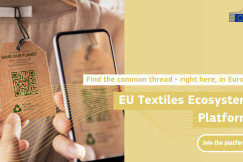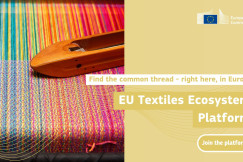Articles
04 June 2025
T-REX Multistakeholder Project Unveils Blueprint to Scale Textile-to-Textile Recycling in Europe
Articles
04 June 2025
Infrastructure
Investments and funding
R&I, techniques and technological solutions
+9 more
Login / create an account to be able to react
-
5

The EU-funded T-REX Project has concluded with the release of a comprehensive blueprint aimed at scaling textile-to-textile recycling across Europe. The project demonstrated the recycling of polyester, polyamide 6, and cellulosic materials into new garments, offering actionable insights to advance circularity in the fashion industry.
Fashion for good
Topics
EU-27
Academic / Research and VET Institutions
Company with 250 or more employees
EU Institutions
Financial Institutions and Investors
International Organisations
National authorities
Networks and Federations / Confederations
NGOs / Non-profits
SMEs (a company with less than 250 employees)
-
Transition Pathway's building blocks
-
-
Infrastructure
-
Investments and funding
-
R&I, techniques and technological solutions
-
Sustainable competitiveness
-
-
Industrial ecosystems
-
-
Textile
-
-
Textiles ecosystem areas
-
-
Fibres, yarns and fabrics
-
Apparel and clothing accessories
-
Household/interior textiles
-
Technical textiles
-
Research and Innovation
-
Technology and Machinery
-
Waste management, reuse and repair
-
Share
The T-REX (Textile Recycling Excellence) Project, funded by the European Union's Horizon Europe programme, brought together 13 stakeholders from across the textile value chain to address the pressing issue of textile waste in Europe. With over 6.95 million tonnes of textile waste generated annually in the EU, the majority of which is landfilled or incinerated, the project aimed to develop a harmonised blueprint for closed-loop recycling of post-consumer household textile waste.
Over a three-year period, the consortium collected and sorted household textile waste, demonstrating the full recycling process of polyester, polyamide 6, and cellulosic materials into new garments. The project also explored sustainable and economically feasible business models, conducted lifecycle analyses, integrated digital tools to streamline closed-loop recycling, and produced circular design guidelines.
Key challenges and possible solutions, as highlighted by Fashion for good, emerged during the project:
- Technical Scalability: Manual sorting remains inefficient and costly. Advancements in automated sorting technologies, such as Near Infrared (NIR) and AI-powered systems, are essential to improve yield and identification of multi-layer or blended garments. Pre-processing is critical and should be co-located with sorting facilities to enhance feedstock consistency.
- Business Viability: Despite the abundance of textile waste, recyclers face challenges due to limited access to quality feedstock and a lack of infrastructure at scale. Improving collection rates and incentivising sorters to provide feedstock suitable for recycling are necessary steps.
- Environmental Impact: Lifecycle assessment results show that textile-to-textile recycling can reduce environmental impact compared to producing virgin fibres—particularly in terms of climate change, water use, and fossil resource consumption. However, these benefits are maximised only when upstream processes (sorting, collection, logistics) are optimised and recycling technologies are aligned with material types.
- Policy and Regulation: To scale textile-to-textile recycling, regulatory frameworks must provide clear, pragmatic, and market-aligned incentives across the entire value chain. This includes fair responsibility-sharing mechanisms, harmonised recyclability standards, and realistic recycled content targets. Aligning End-of-Waste (EoW) criteria with market needs is key to enabling the use of recycled fibres in new products and supporting EPR schemes. As post-consumer textile waste is expected to reach 7.3 million tonnes by 2030, recycling must be recognised as a strategic complement to reuse, repair, and demand reduction—not a standalone solution.
- Consumer Engagement: Educating consumers about the importance of recycling and encouraging responsible disposal of textiles are vital for the success of circular systems.
The blueprint serves as a strategic guide for stakeholders across the textile industry, providing recommendations to overcome existing barriers and scale textile-to-textile recycling in Europe.
Comments (0)
See also
-
69
Takeaways from the event ‘Early Peek into the EU Textiles Ecosystem Platform’
- Categories
- Infrastructure Investments and funding R&I, techniques and technological solutions +28 more
-
5
Welcome to the ‘Community resilience and local economies’ workspace
- Categories
- Infrastructure Investments and funding R&I, techniques and technological solutions +26 more
-
642
Welcome to the EU Textiles Ecosystem Platform!
- Categories
- Infrastructure Investments and funding R&I, techniques and technological solutions +28 more




